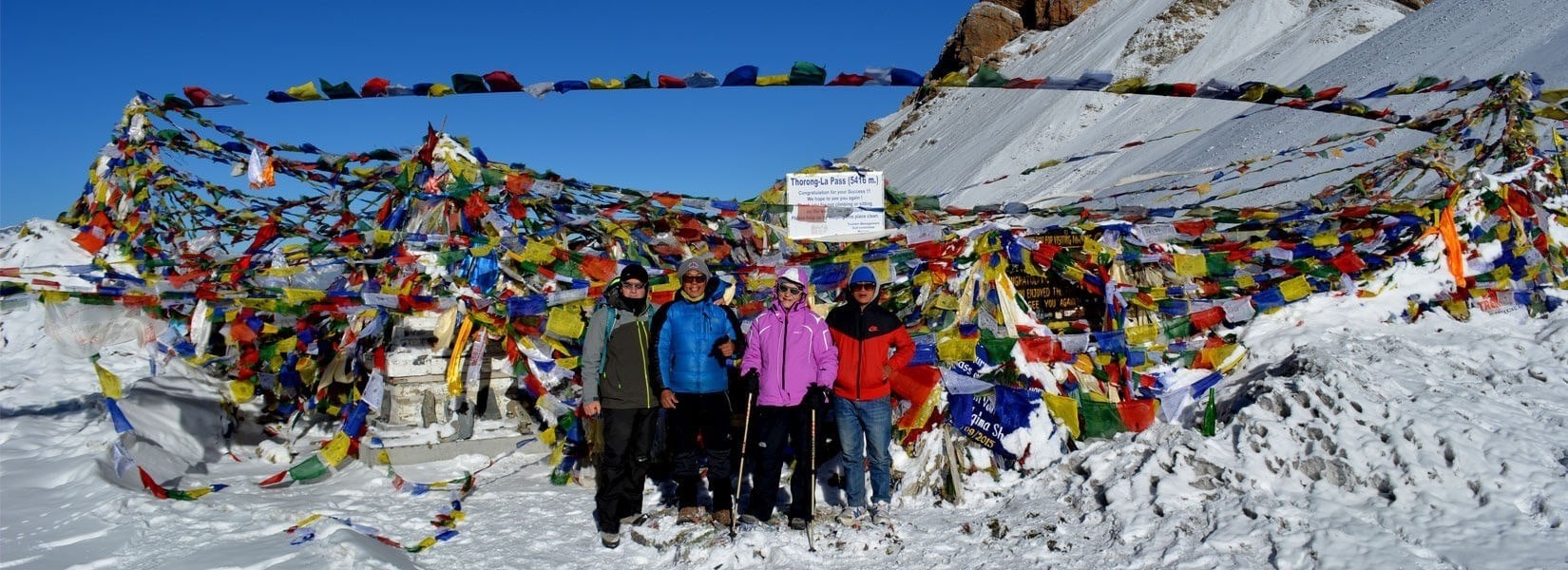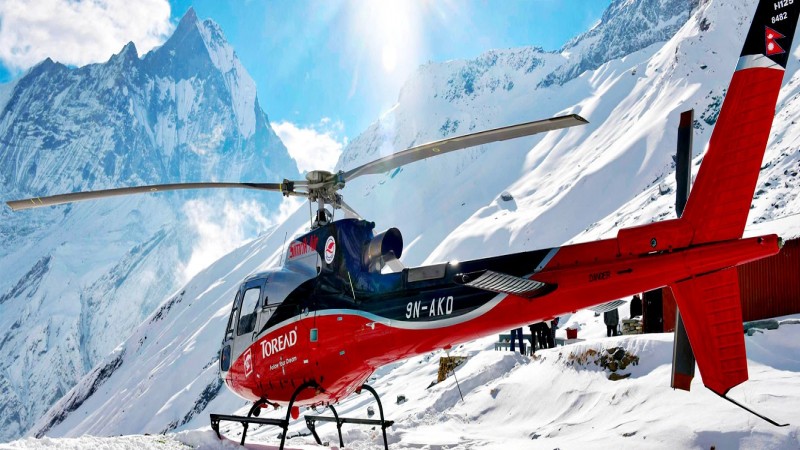Annapurna Circuit Trek is marked as one of the bases of attraction for adventurous trekking lovers in the Annapurna Himalayan region. The Annapurna region is the home of the Annapurna Circuit, which allows travelers to walk through the Himalayan chain of snowcapped peaks while also getting a chance to learn about the lifestyle of the local communities, which is a reflection of the country's rich and diverse culture. In addition, the main route through Manang (3519 m) and Jomsom villages, meeting different people from Gurung, Magar, Thakali, and Tamang communities, and the new colors of culturally rich Nepal are being opened with each step taken.
Trekking around Annapurna is more than a mere adventure for veterans or amateur trekkers. The best part of trekking is that the experienced and the novice are combined in one perfect package – overwhelming chills at high altitudes and magnificent scenery. Customized itineraries that complement the varying speeds and preferences of the trekkers can be arranged for a 10 to 12-day trip to explore this glorious terrain, where we stop for a moment to find solace in every location passed along the way and enjoy it fully. At the heart of the trek is the mantra of gradual rise up through the altitude, a principle that requires all trekkers' careful attention and safety.
The giveaway to the Annapurna Circuit Trek is the thrilling Marshyangdi River surrounding it that silently paves the way for a memorable trip of a lifetime through the core of the Himalayas. Through the panic, trekkers tackle Thorong-La pass, which proudly rises at 5416 meters, and, towards the end, the valley of Kali Gandaki, a magical setting. My solitary trek in the misty snow clouds immersed me in the mighty Himalayan landscape, surrounded by the soaring peaks of the Annapurna Massif, including the famous Annapurna Sanctuary. Each step revealed rugged mountains and pristine wilderness inherent in the Nepalese terrain.
There are cozy tea houses tucked in the landscape with stunning scenery, serving friendly accommodations and local meals. The route to Manang, which runs from the busy streets of the city to the quiet ones which will take you to the summit of Poon Hill and the Annapurna Base Camp, is filled with serenity and adventure. The mornings are filled with golden sunrise colors, and the chilly tops of Thorong La Pass are a testament to the adventurous spirit of trekking in Nepal.
As the journey goes on, trekkers create relationships with the wilderness of nature, where they discover it, and the local people they get to know because they live and see this place. From sipping tea together and exchanging yarn to battling the odds of high-altitude terrain, the Annapurna Round Trek is a transformative event that is more than just having a good time. This unforgettable journey has always remained in the minds of trekkers for a long time.
Annapurna Circuit Trekking Difficulty
Starting the Trek Annapurna Circuit Route can be compared to going on a journey of discovery because it brings trekkers into a whole galaxy of surroundings, ranging from green rice paddies and lush jungles to mountain slopes, spectacular waterfalls, and snow-capped peaks. Thorong La Pass, the highest point of the trek, standing proudly at 5416 meters, is both a physical and symbolic pinnacle, which gives trekkers a breathtaking view as a reward for their perseverance and determination.
As trekkers gradually immerse themselves in the diversifying landscapes, they are amazed at the world's highest mountains, such as Annapurna I-IV, Manaslu, Machhapuchhre, Dhaulagiri, and Tilicho Peak. The differing landscapes, ranging from dense forests to empty desert scenery, that are encountered on the way are just a reminder of the natural diversity in the area and appear to the eyes as something new at every turn.
Nevertheless, the Around Annapurna Trek is about its natural beauty and Nepal's cultural heritage, which the trekkers can see. From meetings with native communities to visits to ancient monuments and temples, you will walk through a rainbow of cultures and traditions every step of the trek. From attending sacred mask dances to trekking old fortresses, trekkers are welcome to be part of the Himalayan people's millennia-long traditions, sharing without much effort, language, and border barriers.
Nevertheless, the Annapurna Circuit trek does not include all rainbows and butterflies. Trekking at high altitudes is not easy, especially with the risk of altitude sickness, which must be carefully handled. Nonetheless, with adequate preparation and support from seasoned guides, trekkers will overcome these obstacles and ultimately live more brutally and decently.
While the sun emerges from the grandeur of the Annapurna Massif to glitter upon the rough landscape underneath, it brings forth the real meaning of adventure – discovery, group spirit, and the unique beauty of nature. In every step and every vista, the Circuit Trek to Annapurna takes us into the soul-stirring magic of the Himalayas, leaving an everlasting impression on the hearts and minds of those who dared to take its journey.
Food and Accommodation During the Annapurna Circuit Trek
Food
Throughout your trekking adventure, we ensure your meals are nutritious and replenish you with great-tasting foods served thrice daily. Our menu in tea houses on the route stands out due to the wide range of flavorful dishes available, tailored to different people.
Breakfast: Start your day with delicious Tibetan bread, chapati with cheese or jam, porridge oatmeal, or French toast drizzled with honey or peanut butter. Try scrambled or boiled eggs, an American breakfast, or pancakes if you like savory food. But, of course, no breakfast is complete without coffee, tea, or freshly squeezed juice to awaken your senses.
Lunchtime: Refill your energy with delicious meals like Thukpa soups, traditional Nepalese dhal bhat, momos (dumplings), or a warm bowl of sherpa stew. Choices like pizza, spaghetti, or sandwiches are also available for fans of international flavors. Whether customers hunger for light or heavy food, our menu covers everything.
Dinner: Additionally, it is a chance to enjoy a delicious meal in the peacefulness of the mountains. Once you decide between a dish with momos, Thukpa soups, Dal, or Bhat, or with comforting Tibetan bread, you can have a meal of your choice, whether you crave pasta, steak, or sandwiches. Take in the warm hospitality and the fantastic views all around you.
For those moments of pleasure, the tea houses provide delicious desserts to fulfill your desires. Indulge in unforgettable delights like rice pudding, apple pie, or pastries that make a perfect end to a day of productive walking. However, remember that the package does not contain facilities for extra snacks and diets.
Accommodation at Annapurna Circuit Trek
Tea Houses
During the Annapurna Circuit Trek, accommodation is mainly secured in simple tea houses occupying strategic locations setting the route. The tea houses, concealed among some of the most stunning spots at the highest elevations, embrace the hikers with warmth and comfort, and they transform into a cushion against the hardships of a high-altitude trek. Lodges with authentic atmosphere located in Annapurna Sanctuary, as well as cozy places near Poon Hill and Annapurna Base Camp, offer travelers not only an opportunity to feel at home but also a great chance to discover the traditions andculture of the area. But those who walk this route should not worry – they will be rewarded with peaceful nights under the Annapurna Sky and sunrises that will stun them for the rest of the day.
Besides offering a place to rest after a long day of walking, these teahouses, usually owned by people of the local communities, often become the center of friendly interactions and conversations among trekkers. These homestays offer simple amenities like a hot shower, electricity, and an unwinding terrace overlooking the rich scenery of the Annapurna range, producing a lasting memory for the circuit trekkers. The choice of accommodation also makes the Annapurna Circuit Trek extra unique. One can wake up to the cold misty air at higher altitudes or may miss out on the hike to be on time to catch a glimpse of the sunrise from Poon Hill.
Drinking-Water
At the lofty heights where the Himalayas, the highest mountains, are guarded by the Annapurna Circuit Trek, the significance of sustaining rehydration here is undeniable. While hiking along Annapurna's mountain range with its rugged passes and increasing altitudes, trekkers not only need to bring enough water but also enough water to keep themselves healthy and in good shape. Thanks to the tea houses and water stations on the way, it's easy to replenish water supplies, whether by buying water bottles or utilizing the free water sources provided along the route.
The trekkers planning to do the Annapurna Circuit should have at least 2 liters of water in their durable Nalgene bottles, and their proper hydration levels should be constantly monitored. Although bottled water is available along the trekking route at tea houses, where the average price is USD 1 – 3 per liter, there is also an option to refill water bottles from filtered taps or pure natural sources. Nonetheless, to prevent water contamination in far-off locations, trekkers need to take tablets of water purification and an electric light straw with them; this will help keep the drinking water clean and safe even as the enthusiasts go through the beautiful scenery of the Annapurna massif.
Annapurna Circuit Trek Required Permits and Fees
To begin the Anapurna Circuit Trek, trekkers must have their permits issued and alternative fees paid. Trekkers will obtain permission through ACAP and TIMS. ACAP strives to keep the natural splendor and cultural patrimony of the Annarpatina area while empowering the trekkers with the TIMS card for safety assurance. The fees for these permits vary with the national chit occurring per several seasons, and the rates are adjustable, especially during the off-season. The purpose of this permit is not only to let trekkers use the Annapurna Circuit Route legally, but also to minimize the impact of travelers in these ecologically fragile areas and to conserve these areas to be utilized by future generations.
Annapurna Circuit Trek Permit Costs | Foreign Nationals | SAARC Nationals | Nepali Citizens | |
| 1 | ACAP Per Person | NPR 3000 | NPR 1000 | Non-applicable |
| 2 | TIMS Per Person | NPR 2000 | NPR 1000 | Non-applicable |
Guides and Porters during the Annapurna Circuit Trek
Regarding high-altitude adventure in the Annapurna region of Nepal, trekking along the Annapurna Circuit cannot be overlooked; strategic organization is always in the spotlight, while the guidance of seasoned personnel is indispensable. Appropriately choosing the proper guide with previous experience and a porter is vital for safe travel and a successful Annapurna trek. As a company, we offer adventure and professional guides along with porters for the Annapurna Circuit Route Trek, which becomes the base for trekkers to ascend toward high altitudes without any stress, thus allowing them to accomplish their planned trek.
Through years of studying the Annapurna Ranges, our team of "top-notch" guides and porters has developed a great experience with the trail and local terrain. They know how to help you in your specific situation, though they are usually there to provide you with knowledge. They can enrich the trip with their experience and skills that will leave you with a most memorable hike, from preparing tasty meals and snacks that delve into local cuisines to applying first aid and keeping an eye on safety. Our team is dedicated to continuing this work to better the experience of our trekkers day and night.
Besides the bird's eye view guiding services, we also allow trekkers in their vehicle rental services, which are different from other rental vehicle services because trekkers require unique rental vehicles for the Annapurna Circuit Trek. By maintaining our transport fleet in good condition and employing experienced drivers acquainted with mountain peaks and curve-ridden roads, we strive to provide a safe and convenient delivery service for trekkers, eliminating the hassle and lateness. We will be your companion on the hike to the Annapurna circuit or by exploring other Himalayan treasures in Nepal.
Our company strives to ensure the traveler's safety, skilled guidance, and unique hospitality to create an unrivaled trekking experience.
Note: A porter will be provided for each of the two Trekkers.
Qualities to Consider When Hiring a Guide and Porter
Choosing the Annapurna Circuit Trek guide who meets all the qualifications is paramount to having a safe and fantastic trip. Thus, we offer excellent guides and porters in the following areas.
Government-licensed professionalism: Prefer a guide who the government. Their permit proves they adhere to the sector's standards and regulations.
Extensive trekking experience: Identify guides who have previously taken hikers around the Anapurna Circuit; therefore, they are deficient in difficulty levels.
Comprehensive knowledge of routes and local culture: Select a representative fluent in the climbing routes and the local cultural heritage and traditions related to the people of the communities across the track.
Understanding local history and mythology: Find people who can tell dumb tales and funny incidents about the sites and villages along the trek, and do them justice by making them sound interesting.
Seasonal expertise: The rider should have a guide aware of seasonal changes and possible sudden difficulties. This will allow the rider to adapt and prepare to face those changes.
Proficiency in trail navigation: Ensure that your guide is skillful in leading you through all the Annapurna Circuit trail networks, so lead you to get lost on the wrong track.
First-aid training: Prefer guides who are qualified for first aid and prepared for any medical emergencies that could occur on the trek. The main focus will be on rescuing trekkers.
Emergency response experience: Select tour guides who are experts in handling emergencies, prove their capabilities to stay cool-headed amid unexpected challenges, and take adequate and effective measures when stuck in an emergency.
Some Qualities to Look for When Hiring Porters for the Annapurna Circuit Trek:
Ability to carry heavy loads: It's essential to find porters who demonstrate strong muscles and stamina and can bear any weight between 20 and 25 kilograms, which could encompass backpacks and equipment, since they will be shouldering the luggage.
Capacity to handle multiple clients: Allocate the workload that each porter shall handle, with a maximum of 2 clients' bags to ensure that the porter is not overburdened and that efficient group trekking is guaranteed.
- Helpful and sincere demeanor: Proficiency in English may not be a prerequisite. Resort to hiring porters who display an excellent communicative and caring attitude. They will be the positive segments through which your customers thoroughly enjoy their trips because of their sincere and helpful nature.
Strong people-handling skills: Look for guides with finesse in handling people. This is mainly needed at the Circuit Trek to Annapurna because the guide must be practical at accommodating clients' luggage and ensuring they are as comfortable and safe as possible throughout the journey.
Familiarity with local language and culture: Consider using porters who may communicate in the regional languages and are conversant with local customs. The individuals will be vital in acting as intermediaries between the visitors and the locals, facilitating smooth communication and interaction between the two groups. Thus, the cultural exchange will be enhanced, and communication among the other members will be effective.
Qualifications and experience: Stress that the trekkers must hire licensed and experienced porters for the Annapurna Circuit Trek since they know the path well and are positively experienced, which can ensure a safe and successful journey for you.
By focusing on the essential aspects of competency and reliability while hiring porters for the Annapurna Circuit trail, trekkers can be highly entertained and enjoy majestic views of the Himalayas in the company of useful ones.
Best Time for a Round Trek for Annapurna
The Annapurna Circuit trek turns out to be an adventurous trip through the scenic Annapurna region, and the number of seasons is a very determining factor for the quality of the experience. Trekkers know spring is their preferred season for trekking due to fair weather and magnificent flower blooming,usually lasting three months, from March through May. On the way, they find rhododendron-covered trails that make the scenery of the trekking route even more incredible. For mild temperatures, clear skies, and monsoon rains, the trekking is enjoyable and safe, while the local cultural festival in the area enhances the knowledge of the traditions and customs.
The autumn journey of the Annapurna Circuit is another best seasons to consider while planning the trek. Here, trekkers get fresh air, clear skies, and moderate temperatures, making this time perfect for them to conquer the circuit trek, which is rough. The non-existence of monsoon rains reduces the risk of landslides, thus making the trail conditions safer for trekkers. The autumn landscape is also decorated with colorful leaves of red, yellow, brown, and orange, which enhance the beauty of the Annapurna range even more and offer excellent views of the scenery and the surrounding peaks.
Spring and autumn are fantastic for trekkers who want to get deep into the Annapurna region's unknown nature and vivid culture. By undertaking the circuit trail during the period of colorful spring bloom or at the time of the incredible display of autumn leaves, each season gives you a new and memorable trekking experience. The trekkers find comfort and friendship in the tea houses scattered along the trails, where they can rest well and enjoy Nepalese people's hospitality. After all, whatever the chosen season for the Annapurna Circuit trek will turn into a transforming experience, encountering incredible landscapes and cultural encounters, and keeping in your memory of hiking this iconic trail circuit path.






